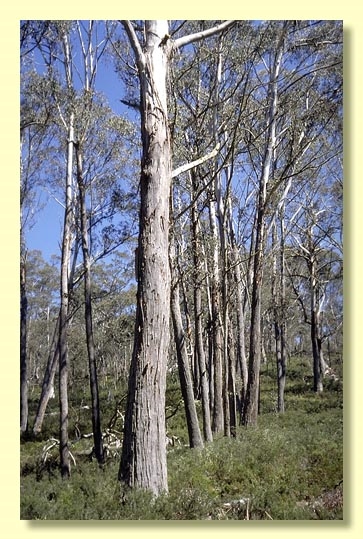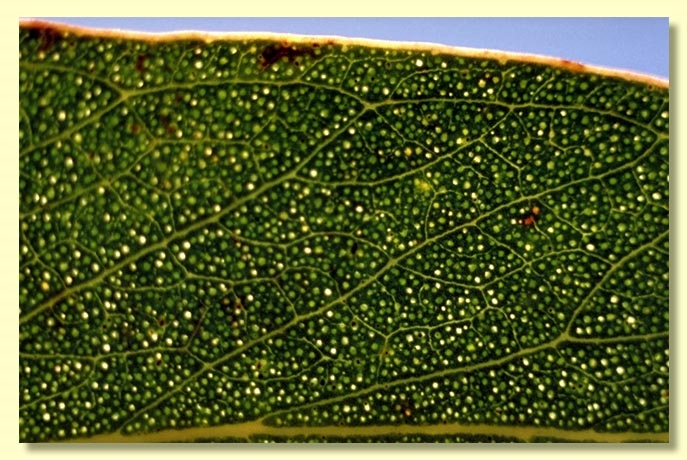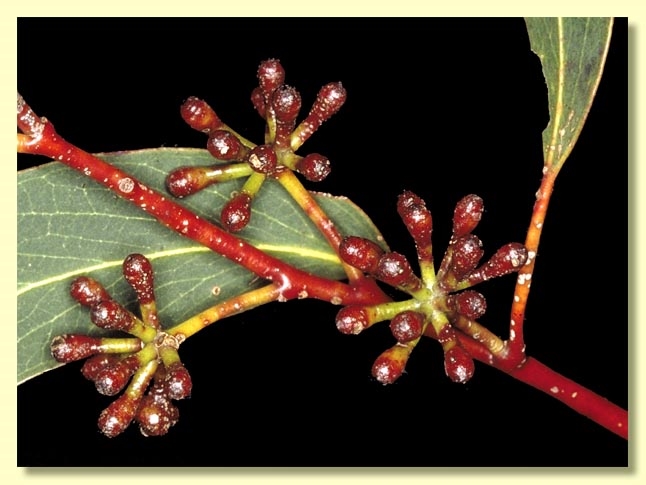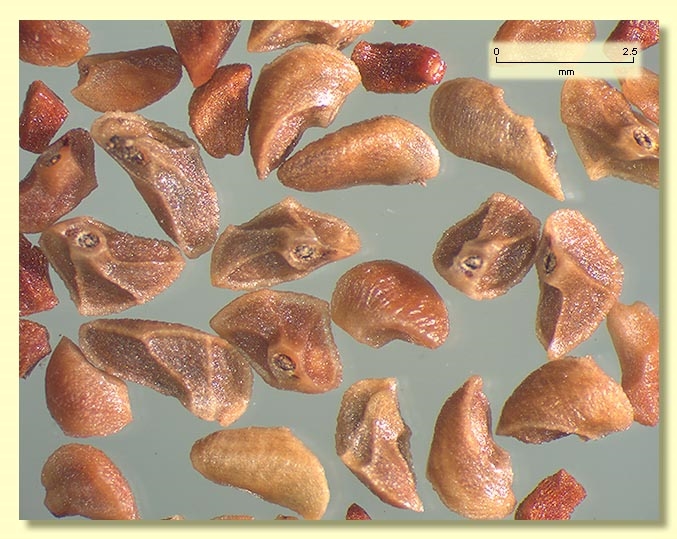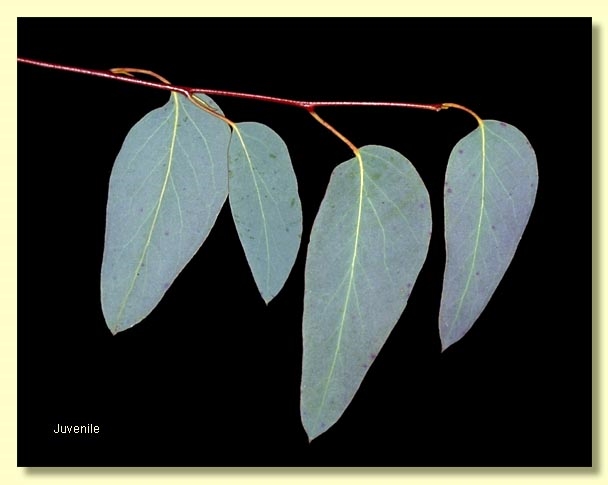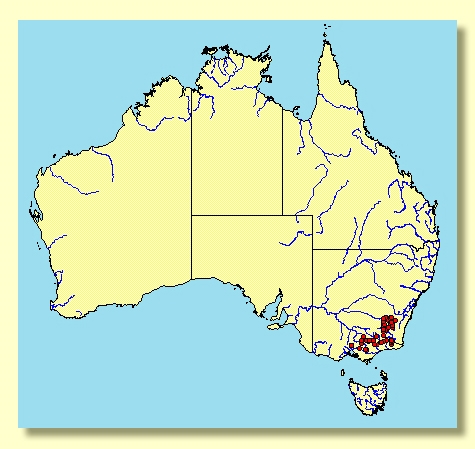Euclid - Online edition
Eucalyptus delegatensis subsp. delegatensis
Classification
Eucalyptus | Eucalyptus | Cineraceae | Fraxinales
Nomenclature
Eucalyptus delegatensis R.T.Baker, Proc. Linn. Soc. New South Wales 25: 305 t. 16 (1900) subsp. delegatensis.
T: Delegate Mtn, NSW, Jan. 1899, W.Bäuerlen s.n.; lecto: NSW, fide D.J.Boland, Austral. Forest Res. 15: 174 (1985).
E. obliqua var. alpina Maiden, Proc. Assoc. Adv. Sci. 9: 369 (1903). T: not clearly designated.
T: Delegate Mtn, NSW, Jan. 1899, W.Bäuerlen s.n.; lecto: NSW, fide D.J.Boland, Austral. Forest Res. 15: 174 (1985).
E. obliqua var. alpina Maiden, Proc. Assoc. Adv. Sci. 9: 369 (1903). T: not clearly designated.
Description
Tree to 50 m (rarely 90 m) tall. Lignotuber absent.
Bark rough on part of trunk, often furrowed, stringy or fibrous, grey to black, sometimes with horizontal black scars; smooth bark white, cream, yellow, grey or grey-green, often with scribbles, occasionally with ribbons of decorticated bark in the upper branches, branchlets glaucous or non-glaucous.
Juvenile growth (coppice or field seedlings to 50 cm): stem rounded in cross-section, glaucous or non-glaucous; juvenile leaves opposite, shortly petiolate for 4 or 5 nodes becoming alternate, petiolate, broadly lanceolate to ovate, 7–20 cm long, 2.7–8.2 cm wide, pendulous, blue-green.
Adult leaves alternate, petiole 1–4.5 cm long; blade lanceolate to falcate, 7.5–23 cm long, 1.3–5.5 cm wide, base oblique or tapering to petiole, concolorous, glossy, green to blue-green, side-veins acute, sparsely to moderately reticulate, intramarginal vein parallel to and well-removed from margin, oil glands mostly island.
Inflorescence axillary unbranched, peduncles 0.8–2 cm long, buds 7 to 15 per umbel, pedicels 0.3–0.5(0.9) cm long. Mature buds obovoid or clavate, 0.4–0.5 cm long, 0.4 cm wide, green to yellow to red, scar absent, operculum conical or rounded and apiculate, stamens inflexed or irregularly flexed, anthers reniform to cordate, versatile, dorsifixed, dehiscing by confluent slits (usually), style long, stigma tapered, locules 3 or 4(5), the placentae each with 2 vertical ovule rows. Flowers white.
Fruit pedicellate (pedicels 0.2–0.6 cm long), barrel-shaped or hemispherical, 0.6–1.1 cm long, 0.6–1.1 cm wide, rarely glaucous, disc level or descending, valves 3 or 4(5), near rim level or enclosed.
Seeds brown, 1.5–3 mm long, pyramidal or obliquely pyramidal, dorsal surface smooth, hilum terminal.
Cultivated seedlings (measured at ca node 10): cotyledons reniform; stems rounded in cross-section, glaucous or non-glaucous; leaves shortly petiolate, opposite, elliptical and discolorous for 3 to 5 nodes then alternate with more obvious petioles, becoming ovate 5–13 cm long, 2–9 cm wide, base truncate, oblique or tapering, apex pointed, concolorous, glaucous or blue-green.
Bark rough on part of trunk, often furrowed, stringy or fibrous, grey to black, sometimes with horizontal black scars; smooth bark white, cream, yellow, grey or grey-green, often with scribbles, occasionally with ribbons of decorticated bark in the upper branches, branchlets glaucous or non-glaucous.
Juvenile growth (coppice or field seedlings to 50 cm): stem rounded in cross-section, glaucous or non-glaucous; juvenile leaves opposite, shortly petiolate for 4 or 5 nodes becoming alternate, petiolate, broadly lanceolate to ovate, 7–20 cm long, 2.7–8.2 cm wide, pendulous, blue-green.
Adult leaves alternate, petiole 1–4.5 cm long; blade lanceolate to falcate, 7.5–23 cm long, 1.3–5.5 cm wide, base oblique or tapering to petiole, concolorous, glossy, green to blue-green, side-veins acute, sparsely to moderately reticulate, intramarginal vein parallel to and well-removed from margin, oil glands mostly island.
Inflorescence axillary unbranched, peduncles 0.8–2 cm long, buds 7 to 15 per umbel, pedicels 0.3–0.5(0.9) cm long. Mature buds obovoid or clavate, 0.4–0.5 cm long, 0.4 cm wide, green to yellow to red, scar absent, operculum conical or rounded and apiculate, stamens inflexed or irregularly flexed, anthers reniform to cordate, versatile, dorsifixed, dehiscing by confluent slits (usually), style long, stigma tapered, locules 3 or 4(5), the placentae each with 2 vertical ovule rows. Flowers white.
Fruit pedicellate (pedicels 0.2–0.6 cm long), barrel-shaped or hemispherical, 0.6–1.1 cm long, 0.6–1.1 cm wide, rarely glaucous, disc level or descending, valves 3 or 4(5), near rim level or enclosed.
Seeds brown, 1.5–3 mm long, pyramidal or obliquely pyramidal, dorsal surface smooth, hilum terminal.
Cultivated seedlings (measured at ca node 10): cotyledons reniform; stems rounded in cross-section, glaucous or non-glaucous; leaves shortly petiolate, opposite, elliptical and discolorous for 3 to 5 nodes then alternate with more obvious petioles, becoming ovate 5–13 cm long, 2–9 cm wide, base truncate, oblique or tapering, apex pointed, concolorous, glaucous or blue-green.
Flowering Time
Flowering has been recorded in January, February and March.
Notes
Eucalyptus delegatensis is a medium-sized to tall forest tree species of high mountain country in southern New South Wales and eastern Victoria, and of lower terrain in Tasmania.
A blue-leaved ash, it is distinguished by the juvenile leaves which are conspicuously pendulous, by the fibrous rough bark, single axillary inflorescences with more than buds and the barrel-shaped fruit. The new growing tips on seedlings and saplings are notably orange-red.
There are two subspecies:
E. delegatensis subsp. delegatensis
Occurs on the mainland in Victoria and New South Wales. It is half-barked and has broadly lanceolate to falcate juvenile leaves to ca 20 cm long.
E. delegatensis subsp. tasmaniensis
Rough over the whole trunk and has smaller to ca 7 cm long, rounder juvenile leaves. It is endemic to Tasmania.
Other species of blue-leaved ash with finely fibrous rough bark are E. andrewsii, a montane and tableland species of northern New South Wales into Queensland; E. consideniana, a fully rough-barked species of coastal and sub-coastal southern New South Wales and Gippsland in Victoria; and E. remota, endemic to Kangaroo Island in South Australia. In Tasmania subsp. tasmaniensis is the only blue-leaved ash species and is easily distinguished from nearby peppermints with similar finely fibrous bark by the seedlings with alternate, petiolate leaves.
Eucalyptus delegatensis belongs in subgenus Eucalyptus section Cineraceae series Fraxinales having the following characters: cotyledons reniform, juvenile leaves alternate, bluish to glaucous, adult leaves with acute side-veins, single axillary inflorescences with buds in clusters of seven to 15, buds with single operculum, irregularly flexed stamens with reniform anthers, ovules in two rows, and seeds ± pyramidal. The closest relatives to E. delegatensis are E. fraxinoides, which differs in compact rather than fibrous rough bark on the trunk and blackish, not brown, seed; and the more northerly E. oreades with its short stocking of rough bark shedding in very coarse ribbons and black seed. A third related species, E. luehmanniana, is a smooth-barked mallee of coastal sandstone areas, with conspicuous quadrangular branchlets and dark brownish seed. Together these four species make up series Fraxinales.
A blue-leaved ash, it is distinguished by the juvenile leaves which are conspicuously pendulous, by the fibrous rough bark, single axillary inflorescences with more than buds and the barrel-shaped fruit. The new growing tips on seedlings and saplings are notably orange-red.
There are two subspecies:
E. delegatensis subsp. delegatensis
Occurs on the mainland in Victoria and New South Wales. It is half-barked and has broadly lanceolate to falcate juvenile leaves to ca 20 cm long.
E. delegatensis subsp. tasmaniensis
Rough over the whole trunk and has smaller to ca 7 cm long, rounder juvenile leaves. It is endemic to Tasmania.
Other species of blue-leaved ash with finely fibrous rough bark are E. andrewsii, a montane and tableland species of northern New South Wales into Queensland; E. consideniana, a fully rough-barked species of coastal and sub-coastal southern New South Wales and Gippsland in Victoria; and E. remota, endemic to Kangaroo Island in South Australia. In Tasmania subsp. tasmaniensis is the only blue-leaved ash species and is easily distinguished from nearby peppermints with similar finely fibrous bark by the seedlings with alternate, petiolate leaves.
Eucalyptus delegatensis belongs in subgenus Eucalyptus section Cineraceae series Fraxinales having the following characters: cotyledons reniform, juvenile leaves alternate, bluish to glaucous, adult leaves with acute side-veins, single axillary inflorescences with buds in clusters of seven to 15, buds with single operculum, irregularly flexed stamens with reniform anthers, ovules in two rows, and seeds ± pyramidal. The closest relatives to E. delegatensis are E. fraxinoides, which differs in compact rather than fibrous rough bark on the trunk and blackish, not brown, seed; and the more northerly E. oreades with its short stocking of rough bark shedding in very coarse ribbons and black seed. A third related species, E. luehmanniana, is a smooth-barked mallee of coastal sandstone areas, with conspicuous quadrangular branchlets and dark brownish seed. Together these four species make up series Fraxinales.
Origin of Name
Eucalyptus delegatensis: after the town of Delegate, southern New South Wales.
Copyright © CANBR 2020, all rights reserved.

Web edition hosted at https://apps.lucidcentral.org/euclid

